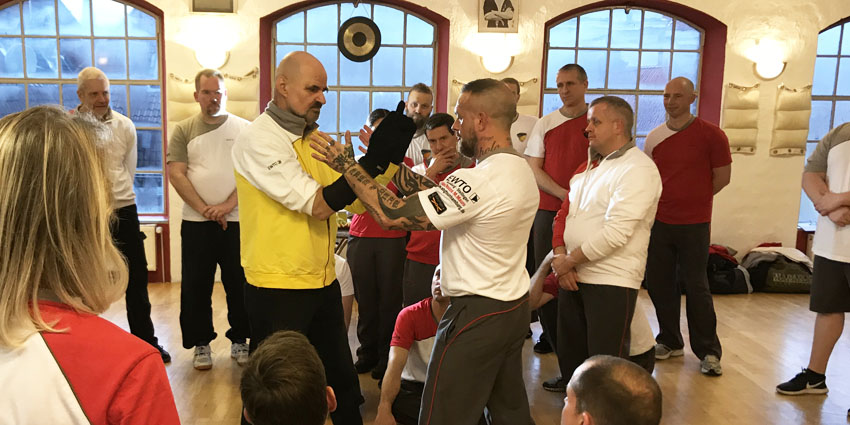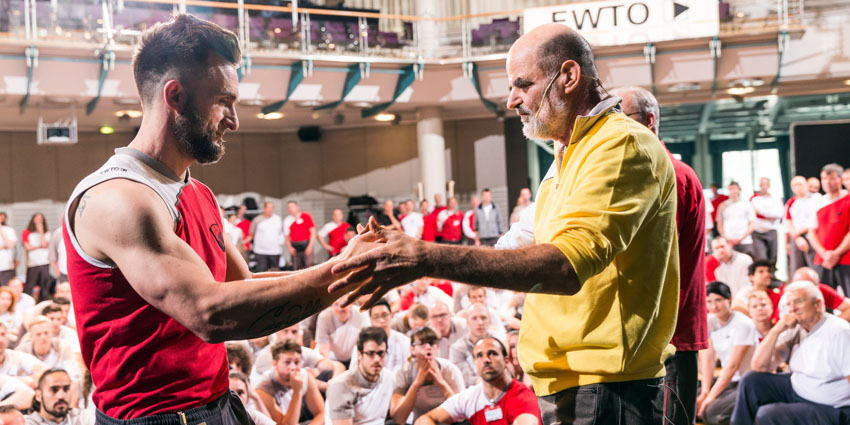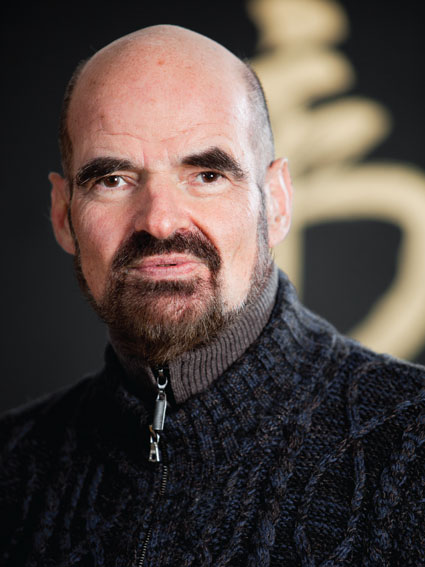Tactile reflex training with "sticky arms"
In this editorial I will explain why tactile reflex training with "sticky arms" is the ideal training for self-defence. You can try it out for yourselves at the Easter Seminar in Großwallstadt near Frankfurt/Main, where I will be teaching it. To set the scene, here is an extract from my coming book on tactile reflex training with "sticky arms", "ChiSao":
 The most important factor in self-defence is to recognise the situation and its inherent danger (but also its opportunities) for us.
The most important factor in self-defence is to recognise the situation and its inherent danger (but also its opportunities) for us.
To do this we must be wide-awake and monitor our senses, which send us 12 million bits of information per second, of which 10 million are via the eyes.
However, we tend to go through life half-asleep, and only pay attention when our mindfulness has already been attuned to certain characteristics. Otherwise it will only be the pain of the first blow – which might be the last – that wakes us up.
Our sense of vision is essential to detect and avert dangers and threats that might be waiting for us around the next corner, or behind a parked van, in advance.
A layman might take the view that the eyes, which are closer to the brain, are more capable of initiating thought processes such as planning and problem-solving than the arms, which are only able to come to grips with and understand problem on direct contact with an opponent. In various languages, "seeing" is used in the sense of "understanding": "How do you see it?", or "I see." (= I understand.) At any rate, visual recognition can help us to avoid walking into many a trap.
A boxer with long arms (like Klitschko) can systematically keep an opponent at a distance and calculate the trajectory of an attack fairly well by extrapolation, so as not to be taken by surprise.
In the case of martial sports such as Boxing, Karate, Stickfighting, etc. it is mainly the eyes that inform us of impending danger.
In self-defence, however – and especially in a sudden ambush – the eyes can no longer warn us of immediate danger, but direct contact felt by the skin, fascia, muscles, etc. can. The same partly applies in Wrestling, Judo or Sambo.
As we all know, the muscles are our largest perceptive organ, and they perceive things directly: what you feel is actually there! Muscles rarely if ever "misinterpret".
It is in the nature of a surprise attack that the attacker is behind the unsuspecting victim, on his flank, on his blind side. The attacker can thereby expect less of a defensive response.
In a fair Kickboxing bout things are different: the attention is fixed on the upper chest of the opponent, while the peripheral vision monitors his hands and feet. Or in some Thai Boxing styles one looks at the opponent's feet and perceives the hands by peripheral vision.
This is why the usual sparring, which relies on the sense of vision, is suitable preparation for Boxing and Kickboxing.
But not for surprise attacks!
While the eyes can only see to the front, and can only recognise things there that are not too close to us – as is the case e.g. in a clinch – the tactile-kinaesthetic sense (muscular sense) can feel, explore and perceive in all directions. Even in the dark, and when blood impairs our vision. This means that when ambushed, we often receive a warning at the very last moment if we have learned to listen to this sense.
The (whole-body) tactile and muscular sense, which I also call the "linkage", is faster and harder to deceive than the visual sense. But in sparring one usually has more time unless one is at very close quarters (e.g. in a clinch).
Evildoers, on the other hand, don't want to give their victims time to defend themselves, which is why they avoid the typical sparring distance. Instead they launch a surprise attack from behind or the front, and if possible they distract the victim's attention like a conjuror.
Those who are trained in physical contact with the opponent still have a good chance of defending and fighting back with fast reactions even though their eyes initially perceived nothing or their attention was distracted.
With tactile training you give your arms eyes and make an attacker leg it!
With such "seeing arms", it is possible to recognise the intentions of an opponent almost like a clairvoyant, while he is still preparing his attack.
It is also useful to wear a blindfold during some phases of this tactile training.

However, so that "sticking arms" training gives us optimum protection against ambushes, it must not only develop capabilities that merely warn us of an impending or just beginning attack. The opponent's contact must also and immediately (and for his part unintentionally!) make us safe.
Yet even this is not enough. In the ideal case, the pressure exerted by his movement together with our own should cause us to move to his flank or better still behind him. This means that via the "linkage" mentioned above, the opponent's force acting on us at the point of contact must immediately cause us to turn or step into a flanking position.
However, the "linkage" must also be able to operate in the opposite direction: when tactile contact is made, we are able to send a force out directly from the point of contact, through his limbs and to his centre of mass, disturbing his balance and leaving him open to our counter-attack.
One often hears the opinion that Chinese styles are not very suitable for fighting, as they seldom take part in MMA tournaments and are rarely successful when they do. This is true if "fighting" is construed as tournament fighting. However, the Chinese styles which – like WingTsun, Southern Praying Mantis, White Eyebrow, Hsing-I – mainly work with tactile-kinaesthetic methods such as "feeling arms" were conceived for another form of fighting, namely pure self-defence.
Although my team in Kiel in the 1970s was even able to prevail against a boxing team while wearing gloves, competition fighting has never been my aim. Whenever anybody challenged me to such a fight, I preferred to make the following suggestion: "Why don't you lie in wait for me in some dark corner and attack me instead!"
If I am suddenly subjected to a surprise attack, I only have a chance if I am able to respond instantly without thinking. The fastest reaction comes from tactile stimuli, and "sticking arms" are based on tactile stimuli and conditioned movement.
Moreover, I share the opinion of Niels Bohr that the action is not always faster than the reaction, although this is commonly held to be a fact, but that the opposite is the case! This is why I try to deliver my own attacks as reactions to external stimuli whenever possible.
Another important advantage is that the onset of the stress hormone cocktail, which can cause a person under threat to "freeze", is not faster than the reflex-like, preventive blow that often beats the attacker to the punch. The time-consuming decision on which "technique" should be used to defend oneself is replaced by reflexes conditioned by tactile training: the immediate reflex delivers the pre-emptive counter-stroke before the heart has pumped the debilitating stress hormones to the brain. The reflex is faster than fear!
With tactile reflex training, I only need to implant five essential "reflexes" into a student to make him/her capable of dealing with 95 % or more of all possible attacks!
Nonetheless, tactile reflex training also has its limitations:
- To reach the very highest realms in the martial arts, it is eventually necessary to free oneself of reflexes and automatic responses as well, and act fully consciously at all times.
Until that stage we learn consciously, but in a real fight we still react to tactile stimuli – usually without knowing what we did afterwards. - Although "feeling hands" training is the best preparation for sudden attacks in my experience, sparring with power training and self-defence on the ground with a view to standing up quickly must not be neglected, as one can be drawn into what I call "ritual fights" or surrounded by several opponents. This is where the eyes regain their importance, along with endurance and the ability to take punishment.
 As already announced above, I will be teaching this in detail for three days during this year's 4 Grandmasters Event in Großwalldorf near Frankfurt from 20th to 22nd April, while Natalie will cover the role of mindfulness during training in her daily Zhong Xin Dao course.
As already announced above, I will be teaching this in detail for three days during this year's 4 Grandmasters Event in Großwalldorf near Frankfurt from 20th to 22nd April, while Natalie will cover the role of mindfulness during training in her daily Zhong Xin Dao course.
Have I aroused your curiosity? You still have the advantage of using the early booking discount shown below as an advance Easter surprise.
I look forward to imparting my ideas to you in practice over Easter.
Your SiFu/SiGung
Keith R. Kernspecht
Attention early bookers!
Those registering by 08.03.2019 will receive an early booking discount and pay the following:
for three days 250 € instead of 300 € and
for one day 100 € instead of 120 €
The registration form contains important notes about the venue, teaching timetable, overnight accommodation and, not least, the special WingTsun programme which is also available. Naturally the staff at head office will be pleased to help in case of any questions: +49 6221 7262600.
So don't miss out, and register here.
See you soon in Großwallstadt!
Fotos: hm/mg


